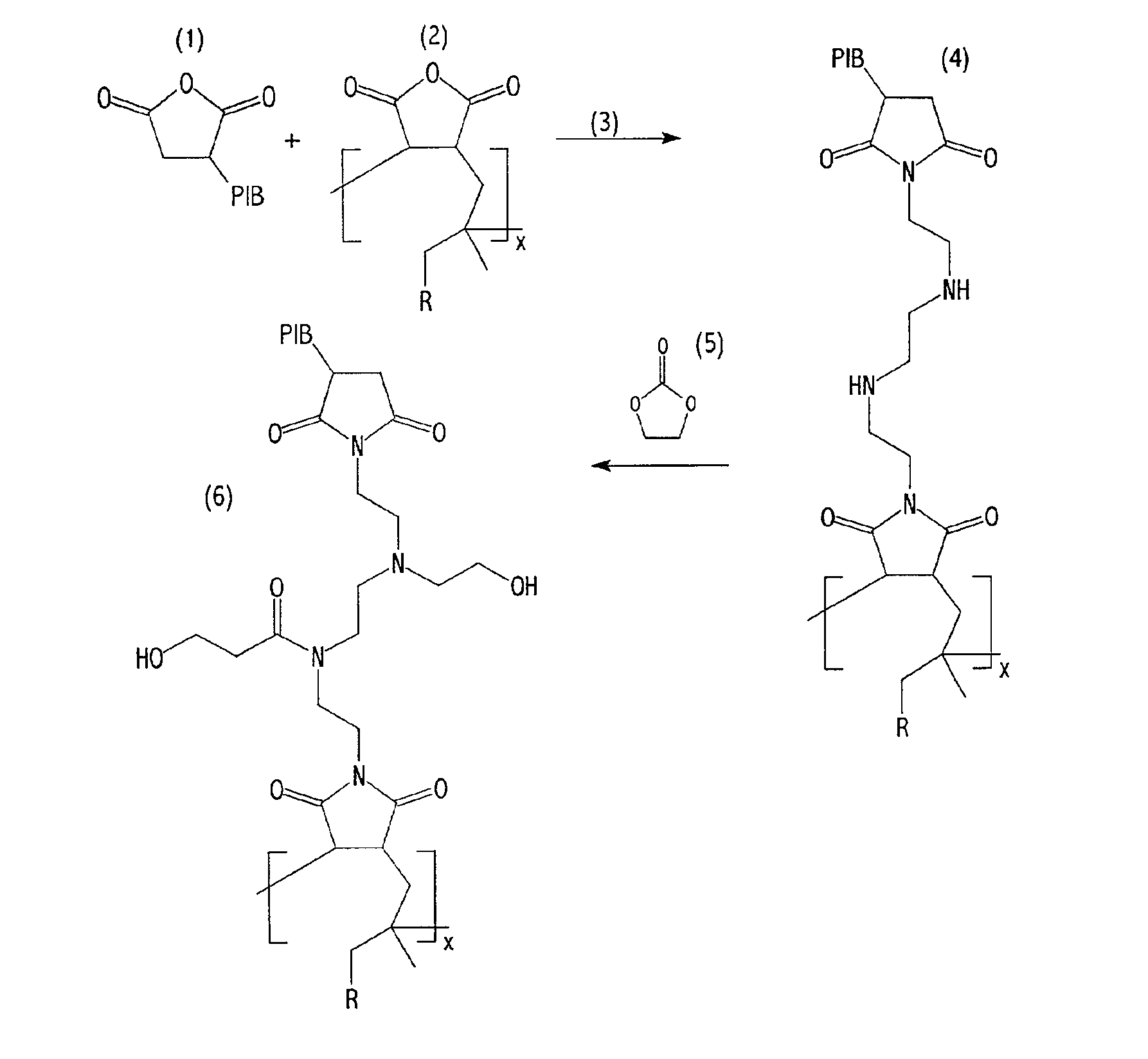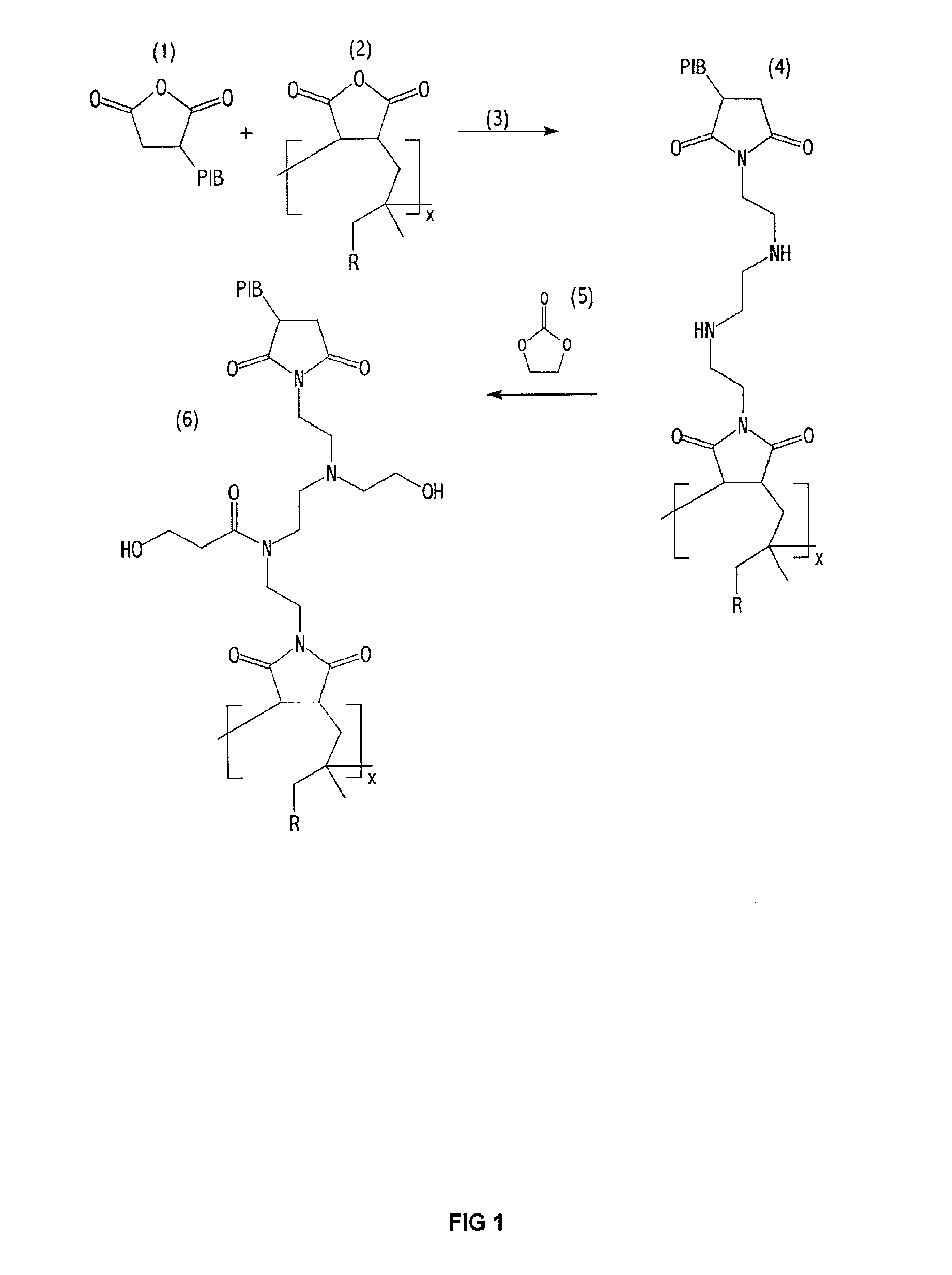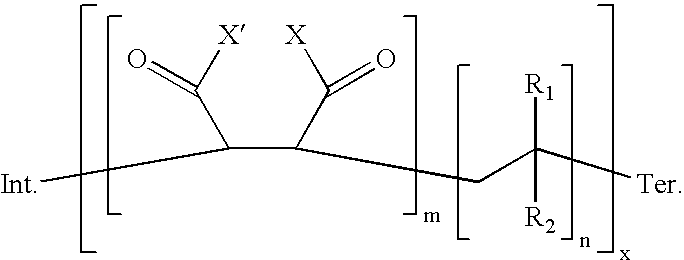Polymeric dispersants prepared from copolymers of low molecular weight polyisobutene and unsaturated acidic reagent
a polyisobutene and polyisobutene technology, applied in the direction of liquid carbonaceous fuels, lubricant compositions, fuels, etc., can solve the problems of high carbon number and high molecular weight, high cost of heating of copolymers, and undesirable solid copolymers
- Summary
- Abstract
- Description
- Claims
- Application Information
AI Technical Summary
Benefits of technology
Problems solved by technology
Method used
Image
Examples
example 1
C8-C28 PIB / UAR Copolymer
Prepared In an Aromatic Solvent
[0193]Low molecular weight PIB,128.01 g (0.57 mol) was added to 157.39g of C9 aromatic solvent in a 1 L three neck flask equipped with a Dean Stark trap, a heating mantle, and a mechanical stirrer. The low molecular weight PIB comprised a mixture of about 47% hexane solvent plus C8 isomer and about 53% C12-C28 isomers. This mixture was stirred and heated at 130 degrees C. to distill out the hexane and the C8 isomers and to azeotrope out any water. To this mixture, 50.31 g of maleic anhydride (0.51 mol) was added. To the resulting mixture, a total of 1.7 g di-t-butyl peroxide (0.012 mol) was added in five portions over a two-hour period. Then the temperature was increased to 150 degrees C. and held there for 3 hours. The aromatic solvent and any unreacted low molecular weight PIB were then removed by distillation at 190 degrees C. under vacuum. A total of 40.96 g of product was obtained. This product had a SAP number of 290 mg KO...
example 2
Predistilled C12-C28 PIB / UAR
Copolymer Prepared In an Aromatic Solvent
[0194]In this example, low molecular weight PIB were first distilled to remove any hexane diluent and any C8 isomers. After distillation, the low molecular weight PIB comprised about 36.2% C12, about 41.4% C16, about 16% C20, about 5% C24, and about 1.3% C28 isomers. A mixture was prepared by adding 427.3 g of C9 aromatic solvent to 520.4 g of the distilled low molecular weight PIB (2.48 mol) in a 3 L four-neck flask equipped with a heating mantle, magnetic stirrer and a Dean Stark trap. This mixture was heated at 134 degrees C. to remove water. Then, to this mixture, 206.8 g maleic anhydride (2.11 mol), and 6.5 ml di-t-butylperoxide was added in five portions over 3 hours. The resulting mixture was then heated at 150 degrees C. overnight. The solvent was then removed in a vacuum to give a product that had a SAP number of 210 mg KOH / g sample. The Mn of this product was 1642, and the Mw was 2250 as determined by GPC...
example 3
C14 Alpha Olefin / Ma Copolymer
Prepared In an Aromatic Solvent
[0195]A mixture was prepared by adding 60.45 g C9 aromatic solvent to 49.31 g tetradecene-1 (0.251 mol). After adding 22.17 g maleic anhydride (0.226 mol) to this mixture, the resulting mixture was heated to 130 degrees C. overnight to remove any water. Then a mixture of 22.17 g maleic anhydride (0.226 mol) and 0.54 g di-tert-butyl peroxide (3.7 mmol) was added in three equal portions over 1 hour to the dehydrated solvent / tetradecene-1 / maleic anhydride mixture. The resulting mixture was heated overnight at 135 degrees C. Then the solvent was removed in a vacuum. A total of 67.09 g product was obtained. The SAP number for this product was 288 mg KOH / g sample. The Mn for this sample was 4188 and the Mw was 7334.
PUM
| Property | Measurement | Unit |
|---|---|---|
| Equivalent mass | aaaaa | aaaaa |
| Fraction | aaaaa | aaaaa |
| Fraction | aaaaa | aaaaa |
Abstract
Description
Claims
Application Information
 Login to View More
Login to View More - R&D
- Intellectual Property
- Life Sciences
- Materials
- Tech Scout
- Unparalleled Data Quality
- Higher Quality Content
- 60% Fewer Hallucinations
Browse by: Latest US Patents, China's latest patents, Technical Efficacy Thesaurus, Application Domain, Technology Topic, Popular Technical Reports.
© 2025 PatSnap. All rights reserved.Legal|Privacy policy|Modern Slavery Act Transparency Statement|Sitemap|About US| Contact US: help@patsnap.com



